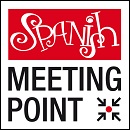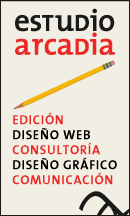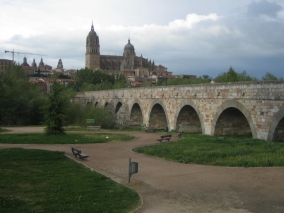Spanish schools and accommodation to study Spanish in Spain
Recent posts
Last schools
introduced
introduced
4 Accommodation

18 Spanish schools

Learning Spanish in Salamanca. The tourist guide to study your Spanish course.
General Information. 156,000 inhabitants. 220 kilometres northwest of Madrid. Salamanca is the second most important city in the Autonomous Community of Castile and León, after Valladolid. It is the university town par excellence, which is widely considered a college life city by many Spanish students. Salamanca has an outstanding choice of schools in which to study the Spanish language. Its university, founded in 1218 by Alfonso IX of León, is the oldest in Spain and one of the four oldest in the world, along with Oxford, Bologna and The Sorbonne, and former illustrious alumni include Antonio de Nebrija and Fernando de Rojas, among others. This internationally known city with an extremely well-preserved historical centre is well worth visiting. Salamanca is a very attractive place to study Spanish with many language schools offering a wide range of Spanish courses.
Surrounding Areas. Those who come to Salamanca to study Spanish would be able to make day trips to the surrounding villages of Spain: Alba de Tormes (20 kilometres), where Saint Teresa of Ávila died in 1582, is a small hillside town with a rich heritage; Peñaranda de Bracamonte (40 kilometres) is famous for its restaurants (suckling pig and roast lamb), as well as several important Renaissance monuments; Guijuelo (50 kilometres), also known as the home of Iberian ham, its cold, dry climate at an altitude of over 1,000 metres being ideal for curing. Salamanca is closed to several small historic cities where Spanish history can be easily learned as well. Béjar (72 kilometres), an important town in Moorish and Renaissance times, and nearby Candelario, a picturesque village of cobbled streets and stone houses; La Sierra de Francia (75 kilometres), which forms part of a Nature Reserve together with Las Batuecas; La Alberca, a beautiful village full of unusual old houses and buildings; Ciudad Rodrigo (86 kilometres), a walled medieval town of great historical significance and an important Episcopal Diocese since the 12th century, still very active today.
World Heritage Site. The entire city of Salamanca was declared a World Heritage Site in 1988. It has an extremely well-preserved architectural heritage: churches, clock towers and the known universities building have contributed to achieve this recognition.
Main Sights. Many Spanish historic cities where you can stay and study Spanish have similar structure to Salamanca, however as for this city in Spain layout is much more beautiful. The Baroque style Plaza Mayor, one of the most beautiful main squares in Spain, really is the heart of Salamanca; on the north side of the square stands the Town Hall. The Old Cathedral (1140), built in the Romanesque style with Gothic features; the New Cathedral (1513), Gothic in style with Renaissance and Baroque elements, the Gothic Casa de las Conchas, so named for its striking facade adorned with 350 stone scallop shells, and which is currently used as a public library, the Plateresque university; the Convent of St. Stephen, with its Churrigueresque style high altar; the Plateresque Palacio de Monterrey, a palace belonging to the House of Alba; and the Roman bridge, which dates from 89 AD. Do you need any other reason to take a walk in this city in Spain and learn about Spanish art and culture?.
Culture. Besides being a historic city where Spanish can be learned, since 2005, Salamanca has hosted the International Arts Festival of Castile and León, a multidisciplinary event combining music, multimedia theatre, graffiti art, theatre, dance... Enjoy contemporany Spanish art and visit one of its museums, it is worth highlighting the Art Nouveau & Art Deco Museum, which opened in 1995 and welcomes more than 120,000 visitors a year, the Unamuno House-Museum and the University Museum.
Shopping. The main shopping area in Salamanca can be found in and around the following streets: Rúa Mayor, Zamora, Toro, Azafranal and Pozo Amarillo. There are also several shopping centres, such as El Tormes, Centro Comercial Abierto, Vialia and Los Cipreses, with a good selection of cafeterias, restaurants and cinemas. So on your travel back, a part from your knowledge in Spanish language, you can take home any souvenir or present.
Gastronomy. It is common to most Spanish cities where you can take Spanish language lessons, but due to its cold winters, Salamanca's gastronomy is wholesome, hearty and tasty, pork being the key ingredient of many of the tapas served in practically every bar and tavern: thick-cut streaky bacon, pork loin, cold cuts, minced pork... The most typical dishes are roast lamb, suckling pig and kid, the hornazo (a traditional pie filled with different types of cured meats), chafaina (made with rice, giblet, lamb sweetbread and pieces of chorizo) and desserts such as the ring-shaped spongy cake called bollo maimón. You will also be able to enjoy the magnificent Guijuelo dry-cured ham and good cheeses with guarantee of origin. The best places for eating and drinking in Salamanca can be found in the old part of the city, around the Plaza Mayor, and in Calle Van Dyck and adjoining streets, where during the summer open up their terrace to enjoy completely Spanish food and weather.
Sports. In Salamanca you can learn or go trekking along the banks of the Tormes River that surrounds the city. Skiing enthusiasts should head for the Béjar-La Covatilla ski resort, which is just 80 kilometres away. Enjoy Spanish nature and combine your Spanish courses by practicing an outdoor sport. There are also several golf courses near Salamanca and various facilities for a number of sporting activities: swimming, football, basketball, tennis...
Fiestas. Spanish traditions talk loads about Spanish culture and help to learn also the Spanish language. Salamanca's Holy Week was declared an Event of International Tourist Interest in 2003; the floats bearing religious statues which are carried through the streets during the processions are genuine religious works of art. The week-long Salamanca Fair gets under way on the feast day of Virgen de la Vega (8th September), when the locals dress up in traditional charro peasant suits and flock to the streets to take part in the religious processions and offer up floral tributes to the city's beloved ‘Virgin of the Lowlands'.
Transport. Salamanca is very well connected to Madrid by dual carriageway and rail. It is a convenient stop-off point on the road linking France and Portugal that crosses Spain diagonally, as well as on the road that runs vertically between Zamora and Cáceres. In the old part of Salamanca, a tourist train offers guided tours during spring and summer. It is easy to get from Salamanca to other Spanish cities by train or by using the various coach services. So if you come to Salamanca to study Spanish, you would easily get to Madrid, Spain capital city, during the weekend and make the most of your stay in Spain.
Nightlife. Students who decide to study Spanish in Salamanca will discover a very active nightlife, thanks to the city's university atmosphere. Salamanca's large student population ensures an energetic nightlife. The busiest areas are Varillas, around Plaza San Justo, packed with bars playing rock, pop and indie music; Gran Vía, with a wide variety of bars and discotheques; Calle Bordadores, a good place to catch some live music; and the central area around Plaza Mayor, with exhibitions, live music and street theatre, not to mention numerous bars, pavement cafés and old-fashioned coffee houses. The college life is the major attraction for the many students who decide to study Spanish in Salamanca.
Useful phone numbers.
Taxis Salamanca...: 923250000
Ayuda en carretera : 900123505
Bomberos................: 080
Cruz Roja.................: 902222292
Emergencias...........: 112
Policía Nacional......: 091
Renfe (trenes).........: 902240202
Turismo....................: 923293100
Entertainment Calendar.
Cinema
Concerts
Theatre and other shows
_________________________________________________________________
SHOPS AND ESTABLISHMENTS IN SALAMANCA.
To advertise here visit this Link.
_________________________________________________________________
Surrounding Areas. Those who come to Salamanca to study Spanish would be able to make day trips to the surrounding villages of Spain: Alba de Tormes (20 kilometres), where Saint Teresa of Ávila died in 1582, is a small hillside town with a rich heritage; Peñaranda de Bracamonte (40 kilometres) is famous for its restaurants (suckling pig and roast lamb), as well as several important Renaissance monuments; Guijuelo (50 kilometres), also known as the home of Iberian ham, its cold, dry climate at an altitude of over 1,000 metres being ideal for curing. Salamanca is closed to several small historic cities where Spanish history can be easily learned as well. Béjar (72 kilometres), an important town in Moorish and Renaissance times, and nearby Candelario, a picturesque village of cobbled streets and stone houses; La Sierra de Francia (75 kilometres), which forms part of a Nature Reserve together with Las Batuecas; La Alberca, a beautiful village full of unusual old houses and buildings; Ciudad Rodrigo (86 kilometres), a walled medieval town of great historical significance and an important Episcopal Diocese since the 12th century, still very active today.
World Heritage Site. The entire city of Salamanca was declared a World Heritage Site in 1988. It has an extremely well-preserved architectural heritage: churches, clock towers and the known universities building have contributed to achieve this recognition.
Main Sights. Many Spanish historic cities where you can stay and study Spanish have similar structure to Salamanca, however as for this city in Spain layout is much more beautiful. The Baroque style Plaza Mayor, one of the most beautiful main squares in Spain, really is the heart of Salamanca; on the north side of the square stands the Town Hall. The Old Cathedral (1140), built in the Romanesque style with Gothic features; the New Cathedral (1513), Gothic in style with Renaissance and Baroque elements, the Gothic Casa de las Conchas, so named for its striking facade adorned with 350 stone scallop shells, and which is currently used as a public library, the Plateresque university; the Convent of St. Stephen, with its Churrigueresque style high altar; the Plateresque Palacio de Monterrey, a palace belonging to the House of Alba; and the Roman bridge, which dates from 89 AD. Do you need any other reason to take a walk in this city in Spain and learn about Spanish art and culture?.
Culture. Besides being a historic city where Spanish can be learned, since 2005, Salamanca has hosted the International Arts Festival of Castile and León, a multidisciplinary event combining music, multimedia theatre, graffiti art, theatre, dance... Enjoy contemporany Spanish art and visit one of its museums, it is worth highlighting the Art Nouveau & Art Deco Museum, which opened in 1995 and welcomes more than 120,000 visitors a year, the Unamuno House-Museum and the University Museum.
Shopping. The main shopping area in Salamanca can be found in and around the following streets: Rúa Mayor, Zamora, Toro, Azafranal and Pozo Amarillo. There are also several shopping centres, such as El Tormes, Centro Comercial Abierto, Vialia and Los Cipreses, with a good selection of cafeterias, restaurants and cinemas. So on your travel back, a part from your knowledge in Spanish language, you can take home any souvenir or present.
Gastronomy. It is common to most Spanish cities where you can take Spanish language lessons, but due to its cold winters, Salamanca's gastronomy is wholesome, hearty and tasty, pork being the key ingredient of many of the tapas served in practically every bar and tavern: thick-cut streaky bacon, pork loin, cold cuts, minced pork... The most typical dishes are roast lamb, suckling pig and kid, the hornazo (a traditional pie filled with different types of cured meats), chafaina (made with rice, giblet, lamb sweetbread and pieces of chorizo) and desserts such as the ring-shaped spongy cake called bollo maimón. You will also be able to enjoy the magnificent Guijuelo dry-cured ham and good cheeses with guarantee of origin. The best places for eating and drinking in Salamanca can be found in the old part of the city, around the Plaza Mayor, and in Calle Van Dyck and adjoining streets, where during the summer open up their terrace to enjoy completely Spanish food and weather.
Sports. In Salamanca you can learn or go trekking along the banks of the Tormes River that surrounds the city. Skiing enthusiasts should head for the Béjar-La Covatilla ski resort, which is just 80 kilometres away. Enjoy Spanish nature and combine your Spanish courses by practicing an outdoor sport. There are also several golf courses near Salamanca and various facilities for a number of sporting activities: swimming, football, basketball, tennis...
Fiestas. Spanish traditions talk loads about Spanish culture and help to learn also the Spanish language. Salamanca's Holy Week was declared an Event of International Tourist Interest in 2003; the floats bearing religious statues which are carried through the streets during the processions are genuine religious works of art. The week-long Salamanca Fair gets under way on the feast day of Virgen de la Vega (8th September), when the locals dress up in traditional charro peasant suits and flock to the streets to take part in the religious processions and offer up floral tributes to the city's beloved ‘Virgin of the Lowlands'.
Transport. Salamanca is very well connected to Madrid by dual carriageway and rail. It is a convenient stop-off point on the road linking France and Portugal that crosses Spain diagonally, as well as on the road that runs vertically between Zamora and Cáceres. In the old part of Salamanca, a tourist train offers guided tours during spring and summer. It is easy to get from Salamanca to other Spanish cities by train or by using the various coach services. So if you come to Salamanca to study Spanish, you would easily get to Madrid, Spain capital city, during the weekend and make the most of your stay in Spain.
Nightlife. Students who decide to study Spanish in Salamanca will discover a very active nightlife, thanks to the city's university atmosphere. Salamanca's large student population ensures an energetic nightlife. The busiest areas are Varillas, around Plaza San Justo, packed with bars playing rock, pop and indie music; Gran Vía, with a wide variety of bars and discotheques; Calle Bordadores, a good place to catch some live music; and the central area around Plaza Mayor, with exhibitions, live music and street theatre, not to mention numerous bars, pavement cafés and old-fashioned coffee houses. The college life is the major attraction for the many students who decide to study Spanish in Salamanca.
Useful phone numbers.
Taxis Salamanca...: 923250000
Ayuda en carretera : 900123505
Bomberos................: 080
Cruz Roja.................: 902222292
Emergencias...........: 112
Policía Nacional......: 091
Renfe (trenes).........: 902240202
Turismo....................: 923293100
Entertainment Calendar.
Cinema
Concerts
Theatre and other shows
_________________________________________________________________
SHOPS AND ESTABLISHMENTS IN SALAMANCA.
To advertise here visit this Link.
_________________________________________________________________
© TEXT: SPANISH IN TOUR.
VIDEO: Patronato de Turismo de Salamanca
VIDEO: Patronato de Turismo de Salamanca


























